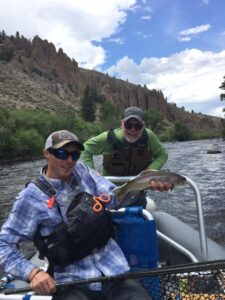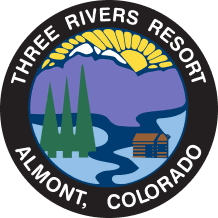During the summer and fall months, the western rivers experience a multitude of hatches which keep trout on the feed. In the Gunnison Valley, anglers try to match these hatches to fool trout. But oftentimes there is more than just one species of insect active in the water column. This is the time when the hopper-double-dropper rig can produce a lot of fish. As a guide, I frequently run the hopper-double-dropper rig to keep my clients on fish all day, without having to change flies often or adjust indicator depths. Below, I outline some reasons why the hopper dropper is my go-to trout rig during the summer and fall seasons.
Three Course Meal

One of my favorite aspects of hopper-double-dropper rigs is that trout have 3 flies to choose from, depending on what insects they are hunting and how deep or shallow they are holding in the water column. A typical rig includes a 7’ 2x leader to a size 8-14 hopper or stonefly dry. This is usually a foamy bug with a big wing. This helps it ride high and remain easy to see in all light conditions. Below the hopper, I will run 3 to 6 feet of 4x fluorocarbon (depending on flow and depth) to a tungsten jig nymph. From the jig I’ll run 1 to 2 feet of 5x fluorocarbon to an emerger or pupa imitation.
The jig gets down quick which is essential for many floating scenarios. This weight also gives you strike detection so that even subtle takes will register on your hopper “indicator.” The emerger or pupa, my “flutter fly,” drifts higher in the column than the jig nymph. Therefore, it has a lot of movement in the water. With this rig you are effectively fishing 3 distinct depths simultaneously. Click HERE for a video demonstration of the rigging.
The Shallow Twitch

Clients often ask me how to prevent snags on the bottom when fishing this hopper-double-dropper rig from the boat. The first part of my answer is that the jig nymph will ride upside down, or hook point up, preventing many snags on the bottom. Part two of my answer is what I call the “shallow twitch.” As we float downstream, we will encounter shallower riffles and holding water that seem “too shallow” for our rig. To overcome this, apply drag by aggressively twitching the hopper. As a result, these twitches apply tension to the jig, pulling it up off the bottom before it can get snagged. The bonus of this twitch is that it perfectly mimics a hopper struggling to get out of the water. Some of the most violent dry fly eats I have witnessed have been a result of the shallow water twitch.
If you like throwing hoppers and nymphing, then consider combining the two techniques with this three fly rig. You will find this rig to be deadly in many western rivers. Also, scale down the rig dimensions for small streams, low water, and picky trout, or beef up the rig to fish bigger water and chop. If you want to learn more about this rig, then join me for a day floating the Gunnison River in summer or fall. Tight lines and I hope to see you on the water!

He guides on all of the local rivers including the Gunnison, Taylor, and East Rivers. Three Rivers Resort is the perfect base camp for a variety of fishing adventures. The resort offers cabins, lodge rooms, and vacation homes plus a full fly shop and Orvis Endorsed guide service with premium leases for private fishing on local ranch lands. Contact at 970-641-1303 or www.3riversresort.com.

